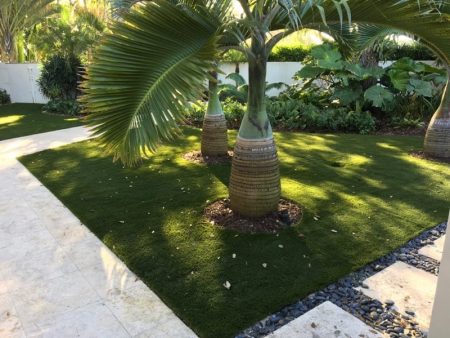 We have long been accustomed to artificial turfs, they can be seen on playgrounds, on the golf course, sports fields, as well as our personal plot near the house.
We have long been accustomed to artificial turfs, they can be seen on playgrounds, on the golf course, sports fields, as well as our personal plot near the house.
In this article, we offer you to consider all the positive and negative aspects of using such a lawn.
– Let’s start with the positive properties of artificial turf:
- In the manufacture of such a lawn using a special synthetic fiber, which looks like a natural grass.
- Such a lawn does not need a “breather”, that is, it can be operated continuously, that is, it is highly resistant to stress and trampling.
- The artificial grass is frost-resistant, does not burn out, is in vertical position, thanks to the elasticity.
- Artificial turf does not require grass scaling, watering.
- It is possible to choose a lawn with the necessary characteristics, depending on the requirements of operation (grass height, density, density)
- Artificial turf has water permeability.
- The color scheme is not limited to natural green, there are also yellow and white colors, which makes marking easier.
-Now let’s consider the disadvantages of such a lawn:
- If the lawn is wet on artificial grass for a long time, moss may form from moisture, which may cause slipping and falling during play
- With strong winds, the lower layer of the lawn is blown out, therefore, additional pouring of the lawn will be required.
- Also, artificial turf requires constant treatment with special antibacterial drugs, since falls and open wounds occur during games to avoid infection and similar treatment is required.
- When using the lawn for different sports, different filling is required, for example, sand is suitable for tennis, football and sand and rubber granules are suitable for tennis, and for the landscape the composition of the filler does not matter.
- Artificial turf must be cleaned from time to time.
- The fill level of the lawn varies depending on the distributed load, so you need to monitor it after every 20 hours of operation.
– Laying of an artificial lawn
The lawn is cut with a sharp construction knife, before laying it is necessary to allow the lawn to lie down, and blades to straighten. Lay the strip very close to each other, to avoid the occurrence of joints, the villi of the lawn should be directed in one direction. The connection of the strips among themselves is carried out with the help of adhesive tape, which is rolled with needles in a roller. The edges of the lawn are fixed with wooden slats. In order for the artificial turf to better adhere to the soil, after laying it it is necessary to water it well.
Picture Credit: turfprosynthetics
